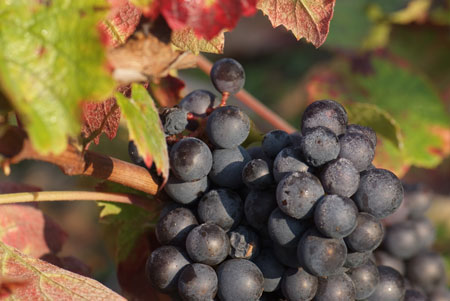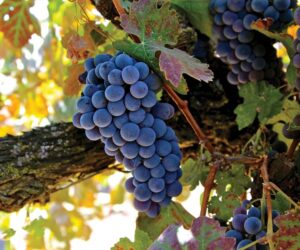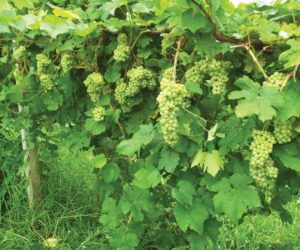
Wine brings people together. This is cause for great reflection for me personally because as you read this, I will have been retired from the University of California Teaching and Research Winery for several months. It is a very sentimental time in my life because of all the contacts I made in my thirteen-year career there. And above all, it all centered on wine. All facets of wine: Teaching, research, and of course, consumption with friends. At the moment, it is the consumption aspect that is giving me pause for reflection.
Let me start this story by traveling back in time to my 29th wedding anniversary. My wife Polly and I were having dinner at one of the local Sacramento restaurants. When it came time to order the wine I was looking through the typical California offerings and was not all that impressed by what was available. So I decide to peruse their European selection. I have to pause the story momentarily to admit that remembering individual producers is a difficult thing for me, but I do remember regions. So back to the story . . . there was a bottle listed that caught my eye: A wine from Côte du Py (Coat-de-PEE). I had taken my summer session students to a Domaine there, so the region was familiar to me. After our visit to the Domaine, we went to a local restaurant where the winemaker joined us. With the help of some wine to open up the conversation, we were able to get to know her and hear more about her life as well as her wines and her approach to winemaking. Fast forward almost six years and here I am with this wine list. The sommelier brought the wine to the table and proceeded to tell us about this unique wine from the Côte du Py and seemed impressed we even knew where the region was. As we were listening, light bulbs were flashing in our heads. It was Mee Goddard, and she was the winemaker whom the sommelier was describing. We had not recognized the name as she had branched off from Domaine Piron (the Domaine myself and students had visited that summer day) and started her own brand. She was masterful in the way she crafted her wines made from Gamay Noir.
Gamay’s Backstory
Gamay is the seventh most planted variety in France and is authorized or recommended to be used in all regions except Bordeaux, Alsace, and the island of Corse. Its history didn’t start out so receptive and it is quite surprising that it is still around at all. The first writings showed up in the literature when on 31 July 1395, the Burgundian Duc Phillipe le Hardi proclaimed this grape to be one that will make you become infected with “serious diseases” and all plantings need to be removed from the country within five months in favor of Pinot Noir. The royal Duc blamed this scourge on Gamay’s “significant and horrible bitterness.”
Gamay Noir is the red grape of the Beaujolais region — where it is too warm for Pinot Noir.
Today, you may think of these as silly notions. But at the time, the Burgundian royalty had significant influence on the region. You have to remember that it was not a democracy. This stigma persisted for 300 years. But there were the believers who understood this grape and how it should best be treated. In some areas it was grown for quantity, rather than quality, but it was the latter viticulturalists and winemakers who created a classic example of the French concept of a sense of place or terroir. This is probably more of a testament to this variety’s versatility rather than people’s perception. While still today Gamay is considered inferior to Burgundy’s other red grape, Pinot Noir, it has found its place in the greater wine world. Though Gamay producers are still fighting an uphill battle to overcome the misrepresentation it received even up to modern times.
Where the terroir concept is most evident in these styles of wines is in the far south of Burgundy. Gamay Noir is the red grape of the Beaujolais region — where it is too warm for Pinot Noir. The region is far enough south so that it is also referred to as the Vallée du Rhône, which is not to be confused with the Côte du Rhône. The Côte du Rhône region is even farther south and downstream on the Rhône River. Outside of France, there are plantings in Switzerland, Germany, Macedonia, Turkey, Lebanon, and Israel. Incidentally, in Eastern Europe it is known a Blaufränkisch. There are also small plantings in Australia, New Zealand, and South Africa. But the most interesting connection to the United States, and specifically California, was in the 1980s, Charles Shaw (yes . . . the actual Charles) tried to launch Gamay under the name Napa Gamay and Gamay Beaujolais. It turns out in both cases; Gamay Noir was not the prevailing grape. There is in fact a smattering of the grape in the Napa Valley, but Jancis Robinson reports that it is Oregon that has more success with the grape.
Working With Gamay
In Beaujolais, Gamay wines were historically made into young and fruity wines using carbonic maceration. Carbonic maceration is a process that involves taking the whole clusters, without crushing or de-stemming, and putting them in a tank. The tank is then saturated with carbon dioxide and left for 5-7 days. The clusters continue to respire, producing higher chain alcohols, which are perceived as fruity. The fruit is then destemmed, crushed, and fermentation allowed to complete, and then pressed. The resulting wines are young, fruity, lacking tannin, and not made for aging. The carbonique style is all about the celebration of the vintage. And while the young wines are sought after, it gives a stigma to the grape in that the style is all the grape is good for. It is a big thing as France, specifically Beaujolais goes out of its way to celebrate this early release of Gamay every year on the third Thursday of November. As we found out on our visit to the Cote du Py, making it in a traditional red winemaking style produces deeply pigmented wines, sometimes aged in oak barrels, but worthy of long-term aging. Every year we go to Domaine Piron, my colleague Dominique will bring out a wine much older than the average student’s age, and we have a contest to see who comes the closest to guess the wine’s age. It’s humbling, but a great learning experience. Some of the wines he brings out are over thirty years old. These examples are a far cry from the Beaujolais-styles that were made alongside it years ago.
. . . while Cabernet Franc is the red grape of the Loire, there are regions where Gamay is produced and made into rosé-style wines
The current prevailing winemaking techniques employ the best of both worlds. Winemakers will de-stem and crush a fraction of the fruit, then add whole clusters to the fermenting must in a proportion of their liking, which is based on their prior experience with the grape. Native fermentations and the use of concrete tanks also round out the techniques of the region. While oak-aging is needed for the aging process, it is not often that new oak barrels are used. Winemakers commonly opt for neutral barrels instead. The emphasis is on the grape, not the wood and tannins.
In the vineyard it is an early-budding grape, making it susceptible to spring frosts. But for cooler regions in the Loire Valley, it is easier to ripen than Cabernet Sauvignon or Cabernet Franc. Therefore, while Cabernet Franc is the red grape of the Loire, there are regions where Gamay is produced and made into rosé-style wines. It is susceptible to most grape vine maladies such as powdery and downy mildew, phomopsis, Botrytis, and bunch rot. It tends to overcrop, so producers can control crop by employing a “green harvest” technique, which involves dropping clusters sometime after berry set and before veraison. In Beaujolais, it is pruned in a gobelet (pronounced go-be-lay), which over time helps to regulate the crop on the vine. Gobelet is the traditional style of pruning for Beaujolais, but with labor becoming more scarce, many growers are turning to trellised vines and more vineyard mechanization.
I have always felt there was a “sense of place” with everything in the wine world. I am referring not only to a grape variety’s presence in a region, but also to the winemaking families that have worked the region for centuries and know what is best, despite the prevailing ruler’s thoughts. To be able to appreciate a wine with friends and to have that wine come alive with a story behind it . . . that to me is the beauty of wine. That night in May 2018, we had a very special bottle because I recognized a region. We had a direct connection to this wine, and what resulted was a togetherness that can span continents.
Gamay Recipe
Ingredients
125 pounds (57 kg) Gamay Noir fruit
Distilled water
10% potassium metabisulfite (KMBS) solution (Weigh 10 grams of KMBS, dissolve into about 50 mL of distilled water. When completely dissolved, top up to 100 mL with distilled water.)
5 grams Lallemand Enoferm AMH yeast (Red Star Premier Cuvee can be used as a substitute)
10 grams Di-ammonium Phosphate (DAP)
10 grams Go-Ferm
10 grams Fermaid K (or equivalent yeast nutrient)
Malolactic Fermentation Starter Culture (CHR Hansen or Equivilent)
Other equipment or needs
15-gallon (57-L) food-grade plastic bucket for fermentation
5-gallon (19-L) carboy
1–2 one-gallon (3.8-L) jugs
Racking equipment
De-stemmer/Crusher
Wine press
Inert gas (nitrogen, argon, or carbon dioxide)
Ability to maintain a fermentation temperature 85–90 °F (30–32 °C)
Thermometer capable of measuring between 40–110 °F (4–43 °C) in one degree increments
Pipettes with the ability to add in increments of 1 milliliter
Step by Step
- Crush and destem half of the grapes. Transfer the must or juice to your fermenter.
- During the transfer, add 7 mL of 10% KMBS solution (This is equivalent of ~50 ppm SO2). Mix well.
- Add the remaining whole clusters to the must.
- Layer the headspace with inert gas and keep covered. Keep in a cool place overnight.
- The next day suspend the Fermaid K in distilled water (~20 mL). Add to must or juice and mix well.
- Prepare yeast. Heat about 50 mL distilled water to 108 °F (42 °C). Mix the Go-ferm into the water to make a suspension. Take the temperature. Pitch the yeast when the suspension is 104 °F (40 °C). Sprinkle the yeast on the surface and gently mix so that no clumps exist. Let sit for 15 minutes undisturbed. Measure the temperature of the yeast suspension. Measure the temperature of the must. You do not want to add the yeast to your cool juice if the temperature of the yeast and the must temperature difference exceeds 15 °F (8 °C). To avoid temperature shock, you should acclimate your yeast by taking about 10 mL of the must juice and adding it to the yeast suspension. Wait 15 minutes and measure the temperature again. Do this until you are within the specified temperature range. Do not let the yeast sit in the original water suspension for longer than 20 minutes.
- When the yeast is ready, add it to the fermenter and mix.
- You should see signs of fermentation within about 1–2 days. This will appear as some foaming on the must surface and it will appear that the berries are rising out of the medium. This is referred to as the “cap rise.”
- You need have on hand the ability to push the grapes back into the juice to promote color and tannin extraction. This is called “punching down” and this should be done 2–3 times per day. Use a clean and sanitized utensil or your hand to mix.
- Monitor the Brix and temperature twice daily during peak fermentation (10–21 °Brix). Morning and evening is best and more often if the temperature shows any indication of exceeding 85 °F (29 °C). If this temperature looks to be exceeded, cool the must by your usual cellar means.
- At about 19 °Brix, dissolve the DAP in a small amount of distilled water and mix into the must
- At about 10 °Brix, break out the de-stemmer crusher and run the must through it to break up the whole clusters and remove the stems. Transfer the newly crushed must back to your fermenter.
- When the Brix reaches zero (about 5–7 days), transfer the must to your press, and press the cake dry. Keep the free run wine separate from the press portion for now. Be sure to label your vessels to keep the press portion separate!
- Transfer the wine to your carboys or 1-gal. (4-L) jugs. Your press fraction may only be 1–2 gal. (4–8 L). Make sure you do not have any head space. Place an airlock on the vessel(s) and be sure to properly label.
- Inoculate with your malolactic (ML) bacteria. Check the manufacturer’s instruction on how to prepare and inoculate. Cover the tops with an airlock to allow CO2 to escape.
- Monitor the ML fermentation (MLF) using a thin layer chromatography assay available from most home winemaking supply stores. Follow the instructions included in the kit.
- At the completion of the MLF add 2 mL of fresh KMBS (10%) solution per gallon (4 L) of wine. This is the equivalent to ~40 ppm addition.
- Place the wine in a cool place to settle. After two weeks, test for pH and SO2, adjust as necessary to attain 0.8 ppm molecular SO2. (There is an SO2 calculator at https://winemaker mag.com/resource/sulfite-calculator). Check SO2 in another two weeks and adjust. Once the free SO2 is adjusted, maintain at this level. You’ll just need to check every two months or so, and before racking.
- Rack the wine clean twice over 6–8 months time frame to clarify and add a little microoxygenation. Fining and/or filtration are generally not needed if SO2 levels are maintained and there are no surface films or indications of subsequent fermentations. Consult the magazine website for tips on fining and filtration if problems are evident.
- Once the wine is cleared, it is time to move it to the bottle. This would be about twelve months after the completion of fermentation.
- Make the project fun by having a blending party to integrate the oak fraction back into the free run. You may not need it all, use your judgement and make what you like.
- If all has gone well to this point, given the quantity made, it can probably be bottled without filtration. That said, maintain sanitary conditions while bottling. Once bottled, you’ll need to periodically check your work by opening a bottle to enjoy with friends.







